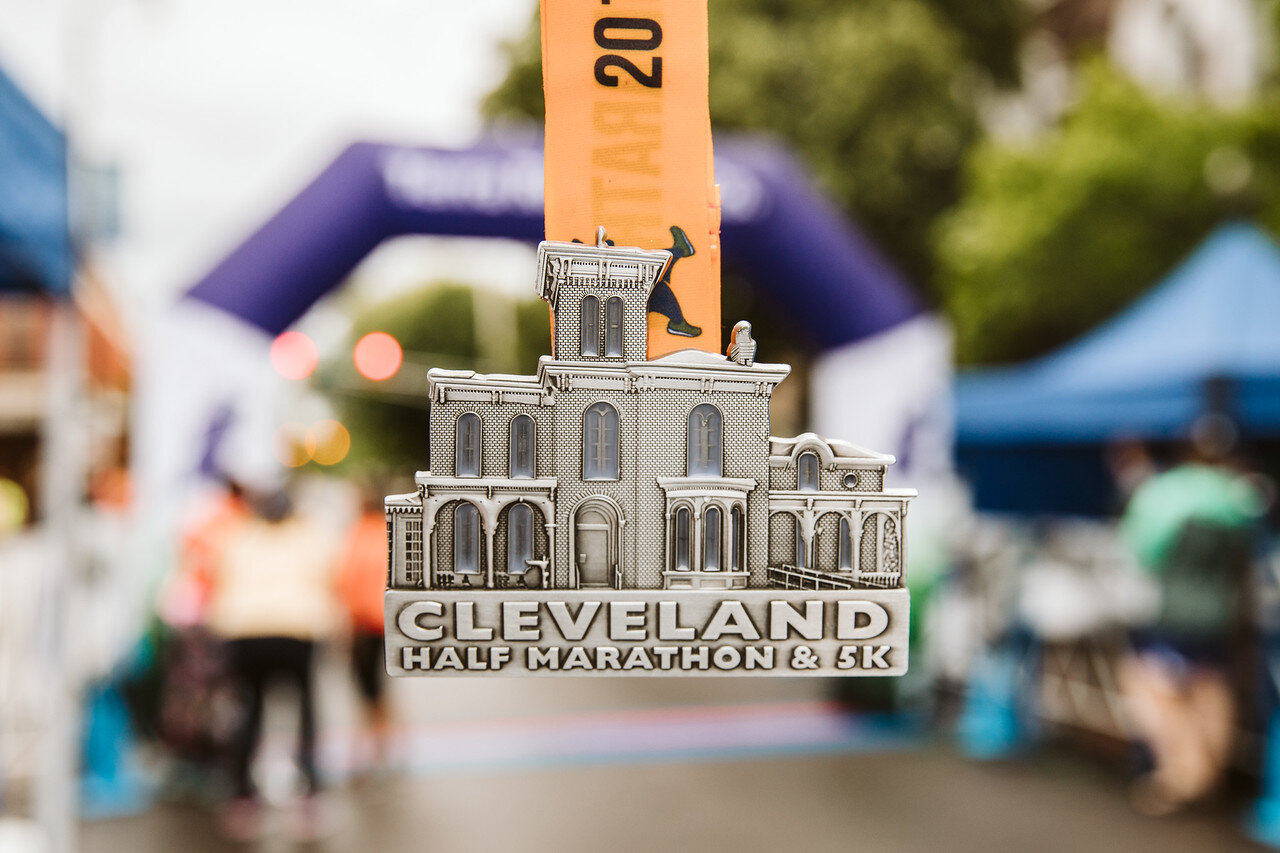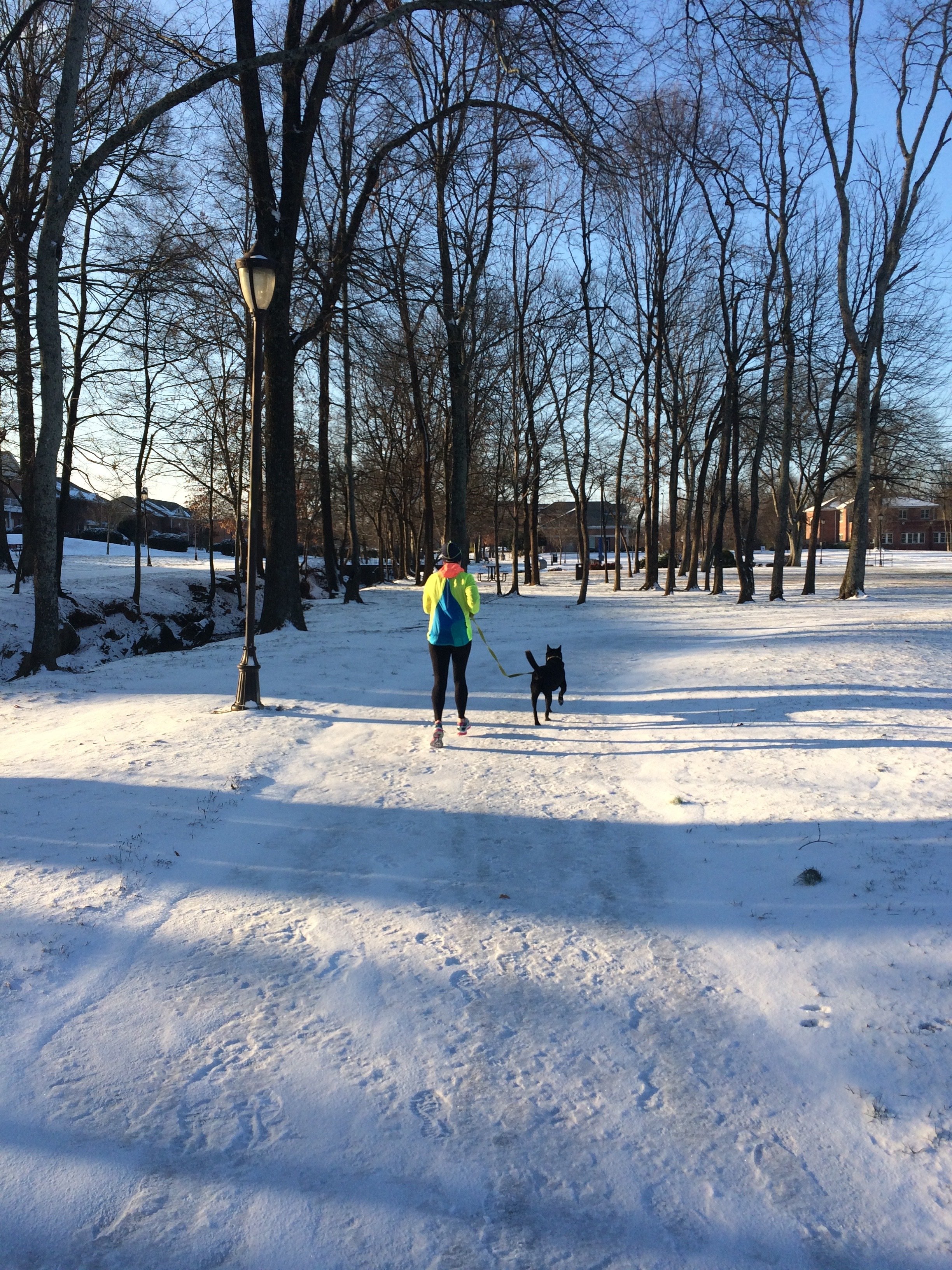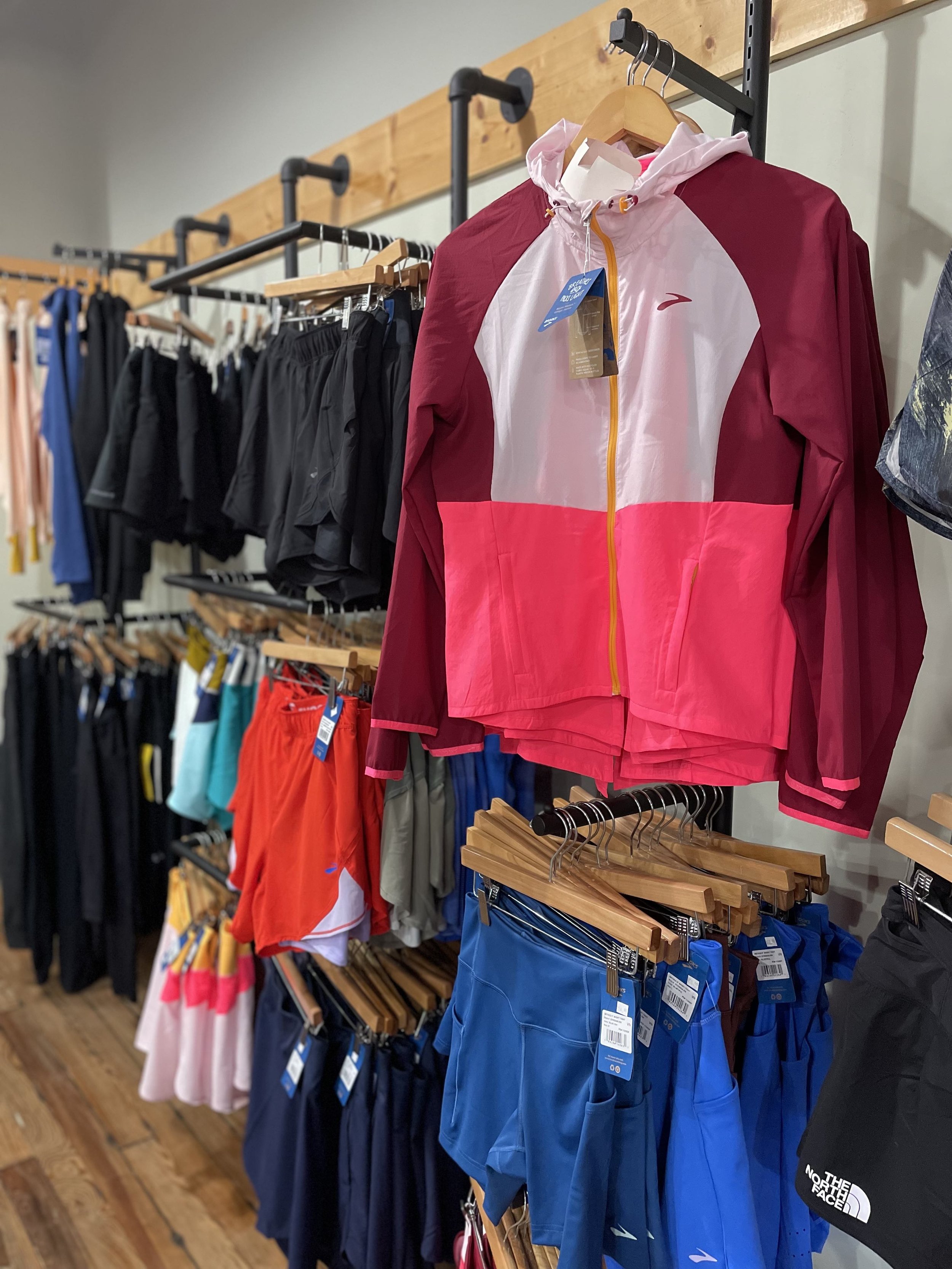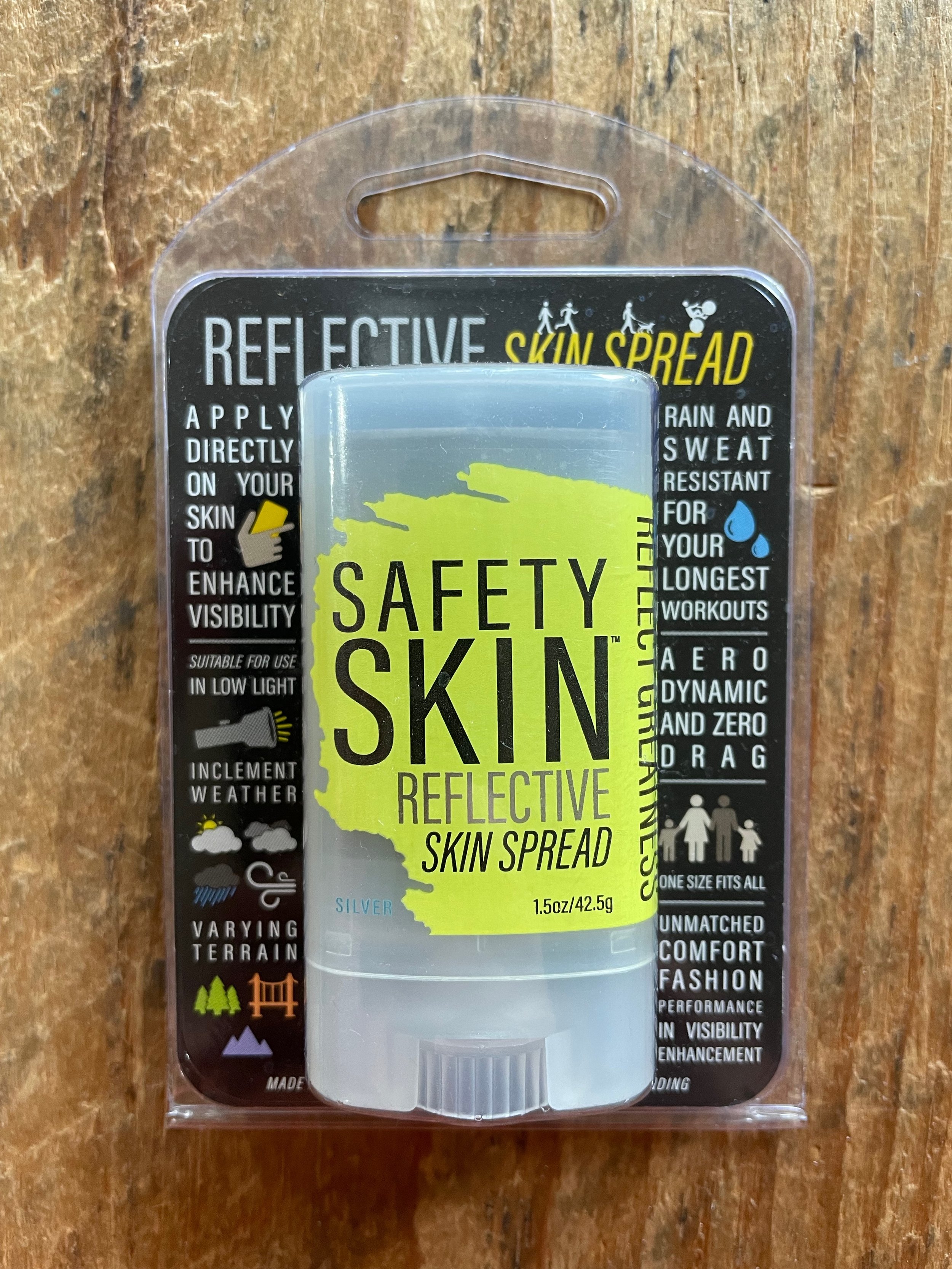
Gear up for cold weather running
The temps are dropping, but that doesn't mean your activity has to slack off or head indoors. If you ask me, the greatest thing about Tennessee winters is it's often still sunny, even when the air temps drop below freezing. If you want to keep up with cold weather running, here are some tips to prepare.
1. When headed out for a cold weather run, dress like you would if you weren't running and it was 20 degrees warmer. For example, if it's 30 degrees F outside but you are headed out for a run, ask yourself what you'd wear on a normal day if it were 50 degrees F outside. You'd dress in pants and a light jacket, with some layers you could unload once warmed up. Don't overdo it just because 30 seems so cold! You're going to warm your body up as soon as you start moving.
2. Layers! On top, dress in lots of layers. Make sure your base layer is always moisture-wicking, never cotton. Dress in a short-sleeve base layer, a long-sleeve over top, and a jacket that you can easily unzip or take off when your body warms up. My favorite winter running jacket is the Brooks Canopy Jacket. There are buttons along the zipper so you can keep the jacket closed but still release heat through your chest. It is also packable into a bag sewn into the jacket.
3. When in doubt, overdress to get yourself out the door. You can always shed layers as you run, but if you're having trouble convincing yourself to get out the door, just throw on another layer (jacket, hoodie, whatever!) to get going. Once you get outside, you'll feel more like continuing. You can always take off a layer, ditch the gloves, and keep it moving!
4. Change your mindset. In just a few short months, it will be back to sweltering heat! We'll be talking about avoiding running in the heat of the day and working hard to keep our electrolytes up because we're sweating so much. Enjoy the brisk weather while you can! The winter is where fast, fit, consistent summer runners are made, so don't skip out on these cool runs if you can!
Cold Weather Running (as told by Team Terra)
What is your must have piece of gear for running in the cold?
Asher: One must-have for me is long socks. If its cold, I can't stand for my ankles to show, no pun intended. Also, if its extra cold, I need my ears covered - so some sort of ear covering/headband is necessary.
Brennan: Thick running socks.
Brittany: Gloves. I really like mittens because your fingers share body heat, but my hands are always the last thing to warm up so running in the cold requires gloves or mittens for me!
Tiff: If it’s actually cold, a mid-weight jacket.
What's your advice on layering for running?
Asher: If I put too many layers on, I start to regret it by the end of mile 1. Warming up happens faster with every layer you have on, so you have you to have just enough to avoid overheating. Thus, its appropriate for me to start out mildly cold, and then end with enjoying the cold breeze. A base layer shirt with one outer jacket usually does the trick. I've always regretted wearing thick joggers on runs, but a wind breaker pant is good.
Brennan: Start with more layers than you’d think, and shed them sooner than you’d think. Your body needs to start warm, but once you’re warmed up, you can go pretty light.
Gloves are a surprisingly effective piece of gear for running in the cold.
Brittany: Start with short sleeve, then long sleeve, then an outer layer. You can shed layers if you layered right, but if you just wear a heavy out layer you won’t be able to shed layers as you warm up.
Tiff: Like Brittany said, start with lighter layers and then add on top of that. This makes it easy to shed layer if you need to. I start with a light layer on all of my limbs before I add other layers. In other words, I would start with a moisture wicking long sleeve shirt and shorts or a short sleeve shirt and leggings. If that’s not enough then I would then wear both a long-sleeve shirt and leggings and then add on top of that either a jacket, a hat, or gloves, (in no specific order) or all of the above.
Let's get some examples: it's 30 degrees, what are you running in? It's 40 degrees, what are you running in? It's 50 degrees, what are you running in?
Asher: With 30 degrees I've got my long socks on, running tights, shorts over that, and a base layer under a thin longsleeve and a wind breaker jacket. Its important for the jacket to have thumb holds in the sleeves. In 40 degrees, I can go with only the shorts and a base layer with the jacket. Long socks are still needed, however. In 50 degrees, I can lose the jacket and the long socks. This weather is warm enough to feel refreshed in just a t-shirt.
Brennan: 50 degrees: shorts & short-sleeve t-shirt; 40 degrees: shorts, long-sleeve t-shirt, maybe a jacket to start, light gloves; 30 degrees: crew running sweatshirt, tights, mid-weight gloves, neck buff.
Brittany: I try to stick with shorts until about 40 degrees. Then anything under 40 I wear pants. That’s easier to do as we get further into the winter because I become more adapted to the cold. I have heard the rule that you should dress for if you weren’t being active and it was 20 degrees warmer. So if it’s 40 out, how would you dress just to go outside in 60 degree weather? Then trust that. Don’t get scared and overdress.
Tiff: I’ll be honest and say that I wear more gear than I probably should because I really don’t want to be cold. At 50 degrees, you’ll probably find me in leggings— maybe shorts — and a long-sleeve moisture-wicking tee, and maybe a hat and a light wind breaker. At 40 degrees: leggings, a long-sleeve moisture-wicking tee, a mid weight jacket, and gloves, maybe a hat. At 30 degrees, you’ll find me in leggings, a warmer, moisture-wicking base layer shirt, a mid-weight jacket, gloves and a beanie.
What's the biggest mistake you see people make when it comes to cold weather running?
Asher: People tend to wear too much for their cold run. I understand the desire, but it only feels good for the first 10 or so minutes.
Brennan: Leaving heavy gear on for the entire run. Even if it feels good to be warm, its extra weight, and you’ll lose fluids faster. You don’t feel as dehydrated since it’s not hot out, but they’re not called sweats for nothing.
Brittany: Overdressing. Layers are fine if you can shed them and tie a jacket around your waist, but trust your gut and know you’ll warm up. Also, don’t stray from tech fabrics just because it’s cold. Running in a cotton hoodie is a sure way to be uncomfortable and really sweaty.
Tiff: Here is where I differ from my colleagues a bit — though people overdress all of the time, I think one of the biggest problems with cold weather running is the mental hurtle it takes to get outside; a lot of people are afraid to dress warmly to run because they know “they’re not supposed to” and then think it’s too cold and never actually get out there. For me, getting out the door is more important than getting a little sweaty or overheating on a daily 3-5 mile run. I say wear what you need to get yourself out the door. If you’re going on a longer run, going to be far out on a trail or aiming for speed my advice would be different, but for your average recreational run, don’t be afraid to wear what you need to gain enough courage to get out the door. As you get more comfortable running in the cold you can (and will!) pivot your getup as needed.
How do you stay motivated to go running when it's cold out? Or do you usually gravitate to another activity?
Asher: Running in the winter is great. You can feel the piercing cold in your lungs and your fingers numbing - this is heightened sensation can only be attained while running in the cold. Cold weather is better for running than hot weather by far. Many athletes actually feel faster in cold weather. Despite the benefits, it can be hard to get out in the cold before you've warmed up. My advice is to find a running buddy or group. Doing an activity with others is generally the best way to feel motivated. If no one is up for a chilly run, however, and you're lacking the motivation, try getting out of your warm clothes and into your running gear. This is the first step to getting out of the door. If you take it step by step you can trick your brain into leaving the comfort of your warm bed.
Brennan: Warm up inside if you can—do dynamic stretches indoors, and you’ll be warm & limber before stepping out the door. And then, if possible, drive to your start point without the heat blasting. Makes it harder to just go back inside, and your car isn’t a cozy place to be either.
Brittany: I try to run when it’s sunniest out, or I run on the treadmill. I do use winter as a time to cross train with classes at the YMCA or swimming.
Tiff: I love getting a good workout in and running is the easiest and most affordable way to do that no matter what the weather. There is also something magical about getting out in the frosty air — even better if there is snow! — and that amazing feeling of getting a hot shower when you come home. That being said, I do usually incorporate a little bit more yoga and strength training into my routine when it’s cold out.
We found the waterfall! And in case you’re wondering, this would be an example of overdressing (or dressing for courage, depending on your philosophy) for a cold weather run…
What's the coldest run you can remember going on? Any fun stories for us?
Asher: I've done several runs in the snow, where I thought, surely, I'd warm up by mile 1, and I just didn't. When running in cold rain or snow, its harder for your body to warm up because of all the moisture. These runs in the snow were painful, but I'd do it again. One thing to be careful of when its extra cold, too, is ice on the road or sidewalk. Slipping and falling in the cold is guaranteed to feel worse than in warm weather. One last point on this note: after your run, you'll want to take a hot shower, but keep in mind that you'll feel better with slowly adjusting to hotter water. Start your shower out with warm water rather than jumping into something steamy - this will be healthier for your body and prevent that weird numb/burning feeling, when your cold skin is met by really hot water.
Tiff: Last year, when I was home in Pennsylvania for the holidays, my dad and I went on a run on the rail trail near my parents’ house. It was icy and very cold out but we were excited to go on one of our legendary running adventures together. He kept telling me about this cool area with a waterfall that was only a couple miles down the trail that he wanted to show me. We kept running and running with no waterfall in sight but thought that surely it must be just around each bend so we kept going. We ended up running about 6.5 miles down this trail before we finally came to that waterfall (my dad originally thought it was only about a mile and a half down the trail — he is notoriously bad with directions)! It was beautiful but we had to hustle back to get to our car before dark since we basically ended up running an impromptu half-marathon; that was definitely a very cold run but it was a memorable winter adventure for sure!
Running Safely
For better or worse we are well into Daylight Savings Time. Right now my Garmin tells me that the sun rose at 7:30am today and will set at 5:27pm. This means that for a lot of people (most people!), when snagging that before or after work run, they will be running somewhat in the dark.
If you are someone who finds yourself hitting the road (or the sidewalk or trail!) during darker hours, it is vital for you to make sure that you are abundantly visible for passing vehicles, cyclists and other runners. While there is more to running safely than visibility, simply ensuring that you can be seen far enough in advance is an easy and simple way to protect yourself and others. Check out these simple tips for staying safe while running during darker hours.
Wear highly visible and reflective clothing.
Did you know that there is a difference between something that is highly visible and something that is reflective? Something is considered highly visible if it is uses bright colors and high contrast. Something that is reflective isn’t necessarily bright but will reflect light. For the best level of visibility you will want clothing and accessories that are both highly visible and reflective.
Put reflective pieces on moving body parts
To increase visual recognition put reflective items on moving body parts like legs and arms — this helps cars recognize you as a moving person, versus just something reflective on the side of the road. If you don’t want to buy a bunch of gadgets and accessories to give you the reflection you need consider trying Safety Skin, a reflective skin spread that comes in a roll on stick. This will let you apply a line of reflectivity wherever and whenever you need it.
Wear a headlamp and/or a light of some kind.
This will not only help you see where you are going but will also help cars see you. Consider lights that blink or flash for even more visual recognition. There are a lot of great clip on options if you don’t want to hold anything in your hand!
Run on sidewalks where able and on the left side of the road when there is no access to a sidewalk.
Sidewalks are obviously going to keep you safer than running on a road in the dark but when that is not possible run on the left side of the road. This will give you a chance to see any incoming cars which will give you time to react if there is a problem.
Run in well lit areas.
While this isn’t always possible, it will greatly increase your safety both from cars (as well as dangerous people) while on your run. Here in Cleveland consider running on Lee University’s campus or heavily trafficked areas of the Greenway.
Run with a friend or in a group.
When it’s dark out consider running with a partner or a group; not only will it add accountability to your running routine it will also help keep you safer. Did you know that we have a weekly group run that meets up at Terra once a week? We meet at 5pm and 5:30pm on Mondays! We run 2 miles at each time slot so if you want a 4 mile run with us, come at 5 and stay for 5:30 or if you only want 2 miles, come at 5 or 5:30. Also, qualify for and join our Terra VIP Facebook group to find running partners!
Stay aware of your surroundings and ditch headphones.
While a lot of us love blasting our music while running that’s definitely not the safest option especially when it’s dark. Instead, consider ditching the headphones all together, running with only one bud in, or switching to bone conduction headphones like Aftershokz which will leave both ears open while still giving you all the music your heart desires.
Carry a phone and make sure someone knows where you are going and when you plan on returning.
It may seem obvious but running with a phone adds a significant level of safety to your run. Beyond the ability to call for help if something goes wrong, you can also download apps like RunSafe, bSafe or the Road ID App which have features such a panic buttons, alarms, location tracking, and audio and video recording in emergencies. When heading out in the dark, also ensure that someone knows where you are going and when you plan on returning.
Though it can be tough to get yourself out for a run when the sun isn’t joining you, logging miles in the dark has its own special satisfaction — just make sure to go prepared and be safe out there!
Lee University’s campus at dawn.








